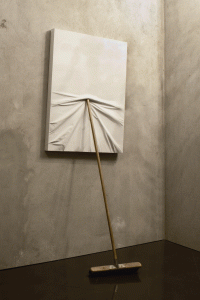« Reviews
Cattelan vs. Cattelan

Maurizio Cattelan, Untitled, 2009, Canvas, wood, and plastic, 82 5?8” X 33 1?2” X 23 5?8.”Courtesy The Menil Collection. Photo:Zeno Zotti
The Menil Collection - Houston
By Héctor Antón Castillo
Maurizio Cattelan is a mainstream name who can already afford himself the luxury of fighting with himself, without fear of failure as far as media impact or controversial coverage is concerned. More than one emblematic piece helps this thoughtful humorist complicate or simplify the nuances of his hyperrealistic tragicomedy. From February until August, 2010, The Menil Collection in Houston is exhibiting a retrospective of works conceived by the artist between 2003 and 2007.
A visual producer well-known on the international circuit stated in an interview that retrospectives are for famous or dead artists. Cattelan removed this bias and looked backwards with a dissoluteness only permissible in the fallacy of art. Thus, we see him intervene in the gallery space with a calmness rendered by the museographically correct and without the necessity of resorting to public scandal gimmicks. This led him to his basic formula: alternating between the mundane and the traumatic by drawing what retinal deception hides or reveals of the physically tangible.
Sculptured figures in white marble simulate bodies covered with fabric alluding to a collective death, a concealment maneuver suggested by Duchamp and carried out on a large political and public scale in the wrappings of Christo. A boy beating a drum seated on the roof of the Menil evokes a scene of military alert taken from the novel The Tin Drum by Günter Grass. Arms “protruding” from the wall exhibit Nazi aesthetics in order to give a Hitlerian “salute” to the public, revisiting the corporal amputations that identify the sculptures of Robert Gober. A hand hanging from a lamp with a finger sticking up indicating a known sign of nonconformity, imitates the predictable and ephemeral Cattelan. A broomstick that supports a blank canvas causing a fold in the center “raids from the prestigious icebox” of the Menil Collection vertical lengths in Lucio Fontana’s fabric.
Once again Cattelan surrenders to a justice impeded from prosecuting a bogus thief because of his referential heists. Jorge Luis Borges said that literature is eternal plagiarism. Contemporary art is as well; however, it is worth clarifying that the similarity should not embarrass anybody. The paradox of this show resides in the fact that it manages to disappoint fans of the artist, while seducing those who experience it for the first time.
Maurizio Cattelan’s retrospective at The Menil Collection proves that great artists are destined to fight against their past importance. On this occasion, the author of controversial, awesome and spectacularly universal pieces, such as, La Nona Hora (1999), Him (2001) or Hollywood (2001) has been outdone by his prior self; however, that does not mean that the fight is over. In such cases, the modest pride of talent should prevail over the arrogance of believing you are immortal before you deserve it.
(February 12 - August 15, 2010)
Héctor Antón Castillo: Journalist and independent art critic. He has collaborated with publications such as: Parachute, ArtNexus, Réplica21, Salón Kritik, among others.
Filed Under: Reviews


































